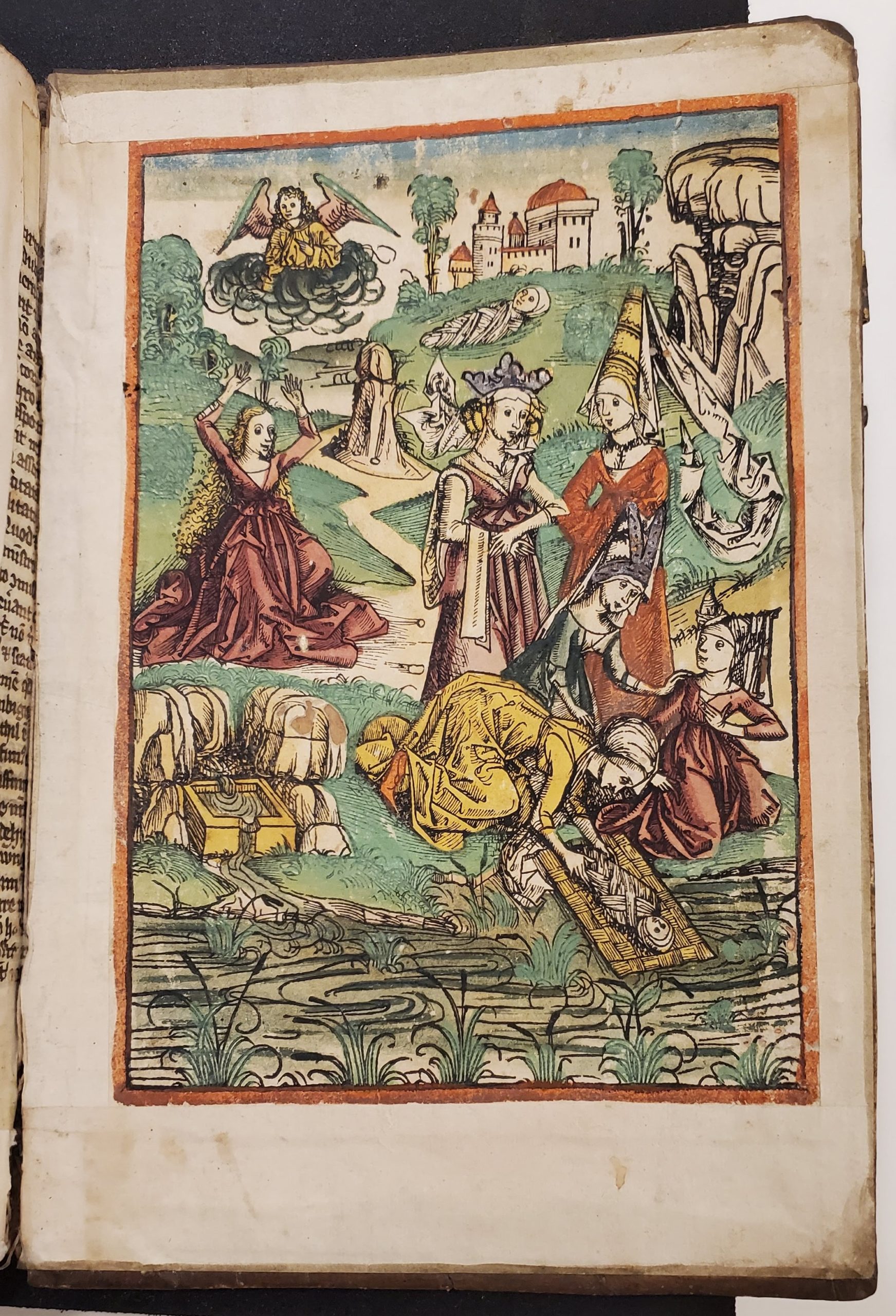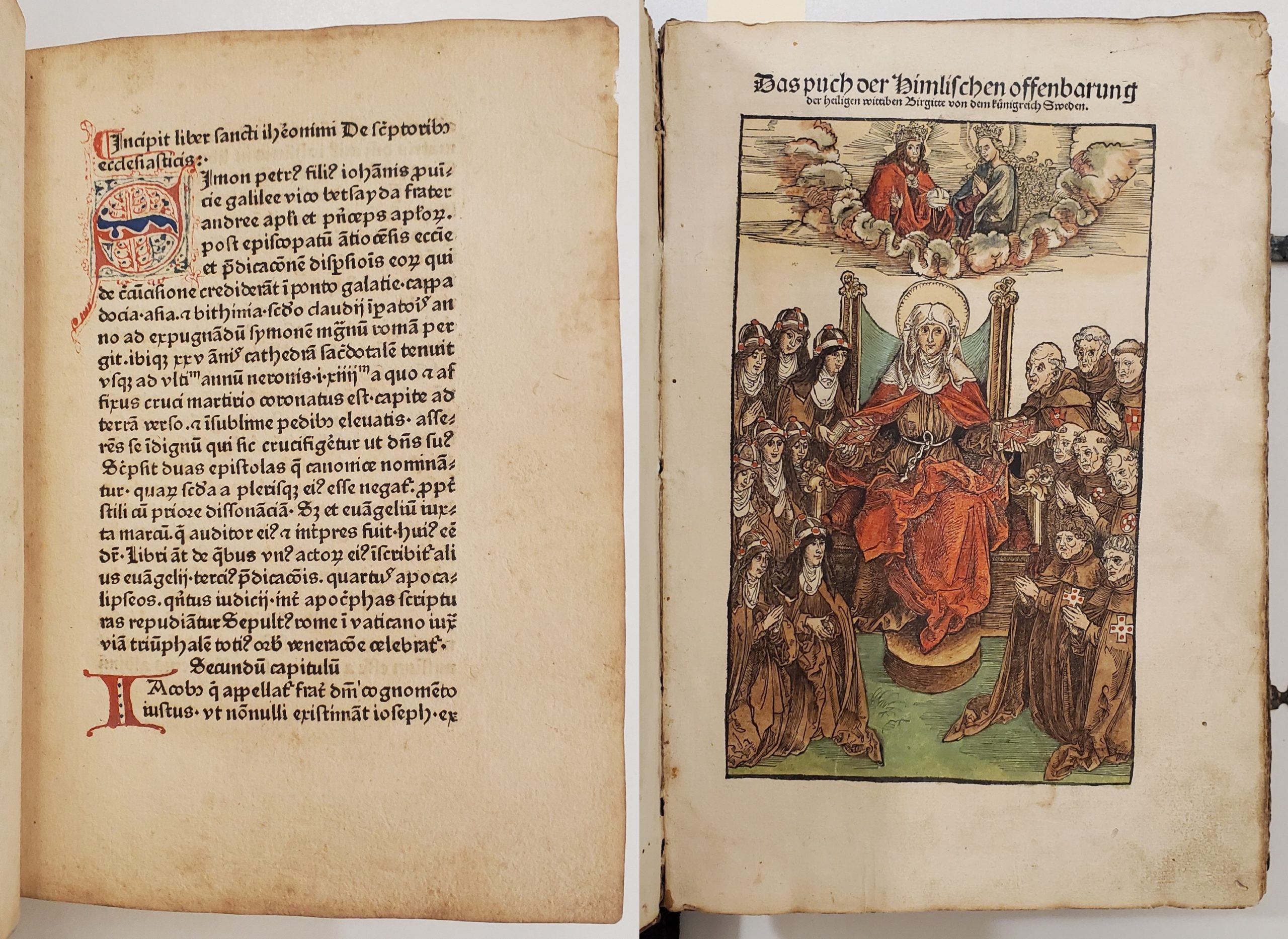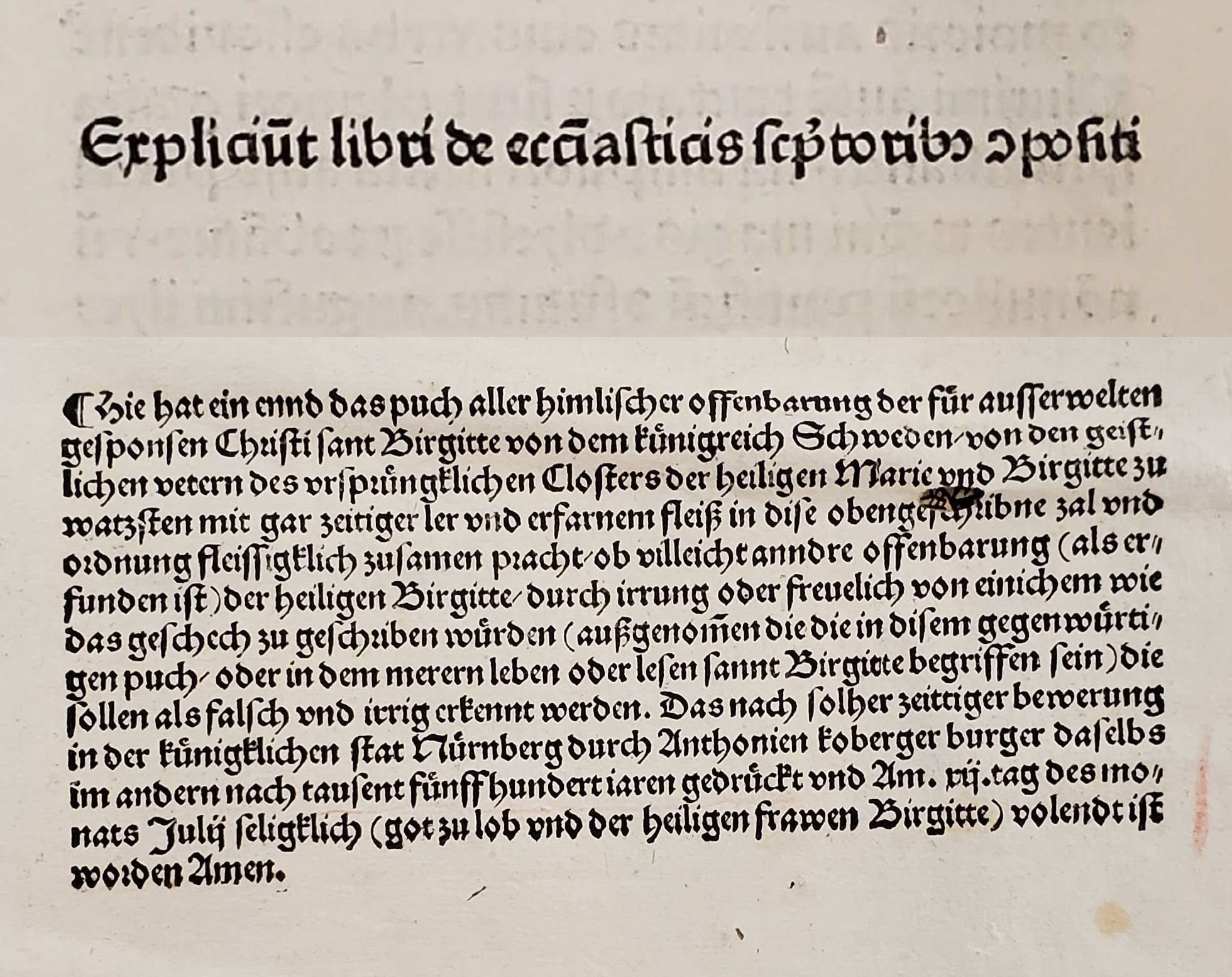
aii recto of De viris illustribus
Over the summer the Clara Thomas Archives and Special Collections acquired two early printed books. The first was Incipit liber sancti ihe[r]onimi De sc[ri]ptorib[us] ecclesiasticis, otherwise known as De viris illustribus. It is comprised of brief biographies of Church leaders written over the course of centuries by three different authors. The first part was written by Saint Jerome in the late fourth century C.E. During this period of early Christianity, Jerome was writing to justify Christian learning in a world accustomed to the learning and culture of pagan authors, therefore he compiled biographies of learned Christian authors to appeal to intellectuals who could be valuable supporters of Christianity. So determined was he to show the intelligence of Church, that he chose his subjects indiscriminately, even including non-Christians such as Seneca, Josephus, and Philo of Alexandria and controversial figures like Origen, who was later labelled a heretic. The second section was written approximately one hundred years later by Gennadius of Massilia, at another time of transition for Christianity. Pagan authors were no longer an issue for the Church and the “classics” were unpopular at the time, so Gennadius saw the need for instruction and wrote further biographies for those looking to find Christian works for education. The final section of this work was written by Isidore of Seville in the early seventh century. Isidore’s contribution was meant to bolster the image of the Spanish Catholic Church as full of men who were both orthodox and capable of a large literary output. The book acquired by ASC contains the biographies written by all three authors and was printed around 1481 by Bartholomaeus de Unkel.

Cover of the Revelations of Saint Birgitta
The second early printed book acquired was Das Puch der himlischen Offenbarung der heiligen Wittiben Birgitte von dem Künigreich Sweden, or the Revelations of Saint Birgitta of Sweden. Birgitta was born in Sweden in 1302-3 and shortly after the death of her husband in the mid-1340s she had a calling vision commissioning her to become the “Sponsa et canale” (bride and channel) of Christ. Her visions argued for reforms in the church and the salvation of humankind, as well as outlined her plans for a new monastic order. Birgitta addressed most of these visions to secular leaders and those responsible for monastic reform with themes of justice and legalism running throughout. She received these visions over the next thirty years until her death in 1371. Birgitta’s monastic order at Vadstena was inaugurated on October 23rd, 1384 and she was canonized on October 7th 1391. Her revelations were initially recorded in Swedish but were quickly translated into Latin by the confessors she had throughout her life. Her last confessor Alfonso Pecha da Vadaterra became the first overall editor of her revelations. As her monastic order grew across Europe and she was canonized, interest in Brigitta’s revelations grew with manuscripts of her revelations produced across Europe that each had their own arrangement and details specific to the region that produced it. In total there are approximately 700 visions over seven books. The first printed version of her revelations, likely based on the manuscript from the monastery at Vadstena, was printed in Latin in 1492. In 1500 the second Latin edition printed in Nuremburg by Anton Koberger. The edition acquired by ASC is the first German edition of the work, also printed by Anton Koberger in Nuremberg in 1502. This edition includes Birgitta’s revelations as well as the Birgittine rule of her monastic order and the bull of Birgitta’s canonization. Luckily for us this book is also in its original binding.

Lower hand-coloured pastedown with manuscript waste (left)
Original bindings allow us to view a book as it was used by its contemporary owners and give us insights into how books from a specific time and place were constructed. This book, for example, was bound in pig skin over pieces of wood and was decorated with stamps of eagles, unicorns, and flowers which were common on German 15th and 16th century bindings. The book also has metal clasps on the fore-edge, a remnant from when manuscripts were written on parchment and tended to cockle and distort in changes to temperature and humidity. Typical of German bindings the strap for the clasp in on the lower board, and the catchplate is on the upper. Inside the book there are hand-coloured scenes from the Old Testament from another early German printed book Schatzbehalter der wahren Reichtümer des Heils pasted to the inside of both covers. Finally, we can see an old manuscript poking out at the front of the book. Manuscripts that were no longer used were often cut up and used to strengthen the spine of other books, and these fragments are known as manuscript waste. The manuscripts used may have been previously damaged or had errors, the material could also have been sacrilegious (for instance, Catholic hymns after the Reformation), or out of date. What different societies used as their manuscript waste can sometimes also tell us about what material was no longer valued by that society. Today, there are projects such as Fragmentarium that attempt to catalogue manuscript waste from around the world, trying to reconstruct texts that are often lost. Clearly each book has something to teach us, but when you combine them together, they can say much more about the development of the book as we know it today.
Not only are these books impressive and worth acquiring due to their age, but they are also important to help us teach about the history of the book. Books printed before 1501 are known as incunabula, or, incunables coming from the Latin “cradle.” It is meant to imply the first years when printing techniques and conventions were being developed. However, this date is largely arbitrary as there is no development in 1501 that meant books printed after this date looked markedly different than the ones printed in previous years. During this period printers relied heavily on the traditions of manuscript culture, carrying over many attributes into the printed book. In the technical sense, only one of the books acquired by ASC is an incunable, De viris illustribus, printed in 1481. The other, Das Puch der himlischen Offenbarung der heiligen Wittiben Birgitte von dem Künigreich Sweden was printed in 1502, and is therefore not considered an incunable. Books like this may sometimes be called post-incunabula, as they still have the character of an incunable. The timeframe is not consistent, but a date from 1501-1540 is sometimes given. The book of revelations by Saint Birgitta could certainly be defined as a post-incunable as it shares some of the same features as an incunabula, but at the same time it also displays evidence of the evolution of the printed book during this period. The titles of these books, and where they are located, displays this development.

Incipit page of De viris illustribus (left) and title page of the revelations of Saint Birgitta (right).
Incipit liber sancti ihe[r]onimi De sc[ri]ptorib[us] ecclesiasticis, the title of the work printed in 1481 is found on the first page of text and begins with the Latin “Incipit” meaning “here begins.” This phrase was used in the manuscript tradition to begin books that were handwritten by scribes. However, only 20 years later, the revelations of Saint Birgitta begins with a page consisting only of a title and illustration, an early form of the title page. The creation of a title page likely came about due to a change in how books were printed, stored, and bought. First, rather than commissioning a single book to be handwritten, the printing press allowed for mass production, which meant that books were printed before they were sold. As books were not bought or sold bound, during storage the first page of text would need to be protected, but sellers also wanted to be able to quickly identify books in their storeroom. At the same time booksellers wanted to be able to market their books for purchase, so a brief phrase that was able to describe the book was ideal for marketing. These necessities precipitated the development of the title page. Despite this development, the title page of the revelations of Saint Birgitta is missing some elements that we are familiar with. There is no information on when, where, or by whom it is printed, what is known as the imprint, instead this information is located at the back of the book in the explicit, and later, the colophon.

De viris illustribus explicit (top) and Revelations colophon (bottom)
An explicit, likely from the Latin “explicitus est liber” meaning “the book is unrolled” was at the end of a manuscript or incunabula to indicate its end, while also often providing information like the title and the scribe who wrote the manuscript. During the rise of incunables explicits were either followed by or completely replaced by the colophon. Colophons contained much the same information as an explicit, the title, printer, place and date of printing but could also be used to praise the book and emphasize its merits. At the end of De viris illustribus there is an explicit, but it simply notes the end of the text and provides no information. In fact, there is no information on the printer, the place it was printed, or printing date on the book. Instead, that was determined through the work of later bibliographers. In contrast, the Revelations of Saint Birgitta does not contain an explicit, but a full colophon which gives us some information to legitimize the source material for the work (for example, that it came from the spiritual fathers close to Saint Birgitta), the title of the book again, the place and date of printing, as well as the printer, Anton Koberger. Koberger is best known for being the printer of the Nuremberg Chronicle. Elements of a book that we are familiar with today needed to be invented and developed, and in just twenty years we can see the changes being made to the first printed books that make it a recognizable format to us today.
Catalogue Records
De viris illustribus: 19096
Revelations of Saint Birgitta: 19097
References
Carter, John, and Nicolas Barker. ABC for Book Collectors. 8th ed. New Castle, DE: Oak Knoll Press, 2006.
Koeppler, H. “‘De Viris Illustribus’ and Isidore of Seville.” Journal of theological studies 37, no. 145 (1936): 16–34.
Koon, Sam, and Jamie Wood. “The Chronica Maiora of Isidore of Seville.” e-Spania 6 (2008).
Searby, Denis, and Bridget Morris. The Revelations of St. Birgitta of Sweden: Volume I: Liber Caelestis, Books I–III. New York: Oxford University Press, 2006.
Werner, Sarah. Studying Early Printed Books, 1450-1800 : A Practical Guide. First edition. Hoboken, NJ: John Wiley & Sons, Inc., 2019.
https://library.princeton.edu/visual_materials/hb/cases/closures/index.html

